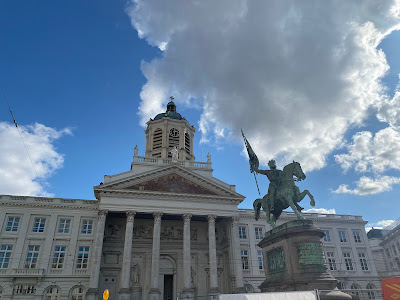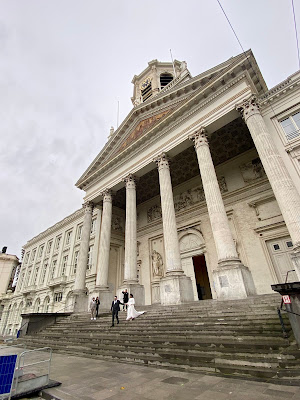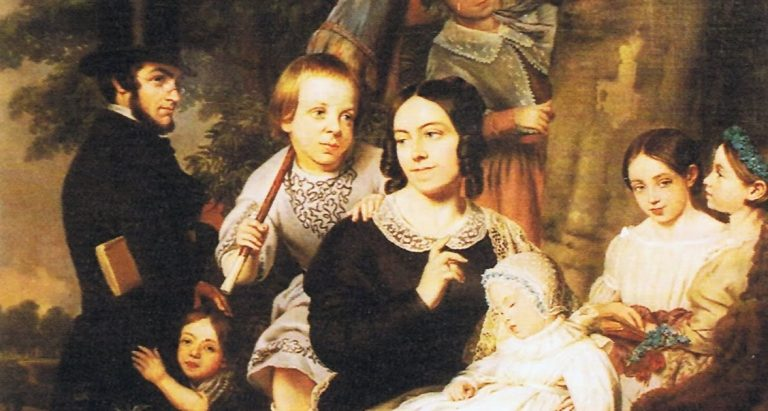 |
| Constantin Heger's Grave |
 |
| Charlotte Bronte |
 |
| Constantin Heger |
Whilst on a wonderful four day visit to Brussels in October 2024, where I had the pleasure of delivering a talk to the Brussels Bronte Group, I had two places on my 'to do' list to visit. Having already spent a long weekend on the Bronte trail in Brussels in May 2018, I hadn't managed to get to these two Bronte-related sites. The first was to visit the grave of Constantin Heger and the second was to pop down to the Waterloo battlefield as Patrick Bronte had done in 1842 after he had dropped his daughters Charlotte and Emily off at Monsieur and Madame Heger's boarding school, the Pensionnat Heger on the Rue d' Isabelle.
This year has been one in which I have already visited several Bronte-related graves! It's what we taphophiles do in our free time! In June 2024 I went in search of Margaret Wooler's grave with my Tipperary, Ireland friend Eileen Prunty at St Peter's Church in Birstall near Leeds. You can read about this adventure here: Margaret Wooler's grave
In May I was with another fabulous Bronte friend Liliana Pasterska, the author of a pamphlet of poetry about Anne Bronte called 'The Third Sister Speaks' and also of a new pamphlet of poems about Emily Bronte called 'Living the Loss' due to be published in early 2025. Liliana and I went to pay our respects to William Smith Williams at his grave in Kensal Green Cemetery in west London. You can read about this visit here: Kensal Green Cemetery
William was the Reader at the publishers Smith Elder & Co and he was the one who recommended that George Smith, his boss, should read and publish Jane Eyre.
 |
| Liliana's wonderful pamphlet of poetry about Anne Bronte |
 |
| Galerie Royale Saint-Hubert |
Now, as I was back in Brussels enjoying lunch in a cafe in the wonderful Galerie Royale Saint-Hubert, I announced to some of the Brussels Bronte Group that I wished to go and find and visit Constantin Heger's grave.
 |
| Helen MacEwan's fabulous book 'The Brontes in Brussels' |
Having studied Helen MacEwan's excellent book called 'The Brontes in Brussels' (Helen is a founder member of the Brussels Bronte group) I knew the cemetery was on the outskirts of Brussels in the Watermael-Boitsfort municipal cemetery on Rue du Buis 57 on the edge of the Foret de Soignes.
One of the group kindly did a bit of research and said I could catch the number 95 bus from near to the Grand Place and walk to the cemetery. But with rain forecast, and not wishing to waste precious time waiting for buses and hoping to alight at the correct bus stop and then having to find the cemetery, I said I'd hop in a taxi. Helen decided she would accompany me and asked if there were two more takers to fill the taxi which there were! The four of us were now on a mission!
We met the taxi outside and, after crawling through the centre, we drove out along a rather grand avenue with lots of large houses many of which are embassies. We passed the Foret of Soignes which Napoleon and Wellington would have known at the time of the Battle of Waterloo and were deposited right outside the gates of the cemetery.
When hunting for a grave it is always worthwhile studying beforehand what the grave looks like if you have a photo to hand and be aware of other landmarks or distinctive graves nearby. Helen had put a photo in her book and, after studying it, I said we needed to look for a sloping gravestone, with two obelisk-type of gravestones nearby, one with a cross on top and two white, small, square buildings with grey slate roofs behind the grave. It shouldn't be difficult!
We walked through the gates and looked around, finding the white buildings first, then we saw the sloping tomb and the two obelisk stones nearby. It took us one minute to find him! In Kensal Green Cemetery, which is huge, Liliana and I had to get someone to help us find William Smith Williams!
We stood by Constantin's grave which he shares with his wife Zoe Claire and one of his daughters Maria. I always chat to the incumbent of the grave! I told him how much Charlotte had been in love / besotted with him and thanked him for being who he was as he had definitely had a lasting effect on Charlotte and probably made her novel writing all the more intense and rich because of their friendship and pupil/teacher relationship.
 |
| The sloping grave |
 |
| Three taphophiles - Helen, Sheila and Ann! |
I then recalled that I had some lavender seeds in my purse from an event in May when, at Anne Bronte's grave in Scarborough, we had been given a handful of lavender seeds that had been gathered from some lavender plants grown in the Haworth parsonage garden to scatter on Anne's grave. I decided to plant a few on Monsieur Heger's grave. There was some lavender growing on an adjacent grave so, who knows, that might self-seed and spread to his grave, or the Haworth parsonage seeds may take and grow. I left a little of Haworth on his grave which I think Charlotte would have liked, but maybe Madame Heger might think otherwise?
As the forecast rain began to fall, we hopped back in the taxi, some to be delivered to a train station and then home and me to return to Brussels centre where I went into the church where Monsieur and Madame Heger and family used to worship, the neoclassical church of Saint Jacques sur Coudenberg, with its impressive cupola and pillared portico. Helen's book also tells us that Leopold I, the first King of the Belgians, was invested in this church on 21 July 1831.
 |
| The Heger's church: St- Jacques sur Coudenburg |
 |
| The pillared portico with a wedding taking place |
 |
| Inside the church where the Hegers worshipped |
 |
| The cupola |
 |
| The Heger family painted by Ange Francois. Constantin is on the left and his wife Clare is surrounded by their children. |
I then felt it appropriate, given I was thinking of Charlotte and Constantin, to pop into the wonderful gothic cathedral Saint Gudule where Charlotte had gone into a confession box and confessed to a Catholic priest on 1 September 1843 when she was feeling very lonely and depressed in the long summer holiday when she was practically all on her own in the Pensionnat. She wrote to tell Emily about this on 2nd September and also included this experience writing about it in chapter 15 of 'Villette'. It is lovely to visit these places and think of the people who came before us and try and understand the emotions they were feeling at the time.
 |
| Saint Gudule Cathedral Brussels |
 |
| Saint Gudule Cathedral |
 |
| The second confession box on the left |
 |
| Is this the confession box Charlotte used on 1st September 1843? |


























































